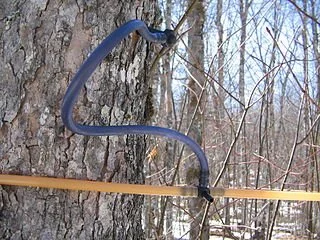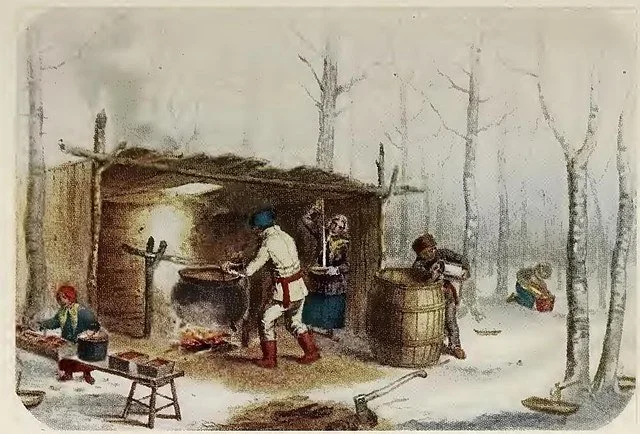It’s a sticky subject: National Maple Syrup Day
By Perry Luckett, CoffeeMan1
December 17 is National Maple Syrup Day, according to the website that tracks such days for those of us who had no idea there could be so many things that deserve a day dedicated to them. It’s easy to get in the flow for this one (I know, painful pun) because maple syrup is downright delicious every day, and lots of foods use it as a direct topping or as flavoring.
How can you best observe National Maple Syrup Day?
Serve up a breakfast (or lunch or dinner) worthy of real maple syrup. You can prepare pancakes, french toast, or biscuits topped off with butter and delicious maple syrup at any meal. Of course, we recommend pairing them with coffee or tea from a cozy cup for best results!
How does this luscious treat get to market?
Old-style tapping of maple syrup in individual buckets. Courtesy Oven Fresh, Public domain, via Wikimedia Commons
Typically, producers make maple syrup from the xylem sap of sugar maple, red maple, or black maple trees, although it’s not limited to those maple species. In cold climates, maple trees store starch in their trunks and in their roots. In the spring, they convert this starch to sugar that rises in the sap. Producers then tap the maple trees by boring holes into their trunks and collecting the released sap.
Modern tapping. Courtesy of Oven Fresh. The central (yellow) tubing runs between a series of maple trees in Canada, occasionally branching off and tapping at the best picks.
Tapping maple sap begins as early as the middle of February and continues through April, depending on weather conditions. The sap is a clear liquid when it’s tapped from the tree. After producers collect it, they process it by heating to evaporate much of the water, leaving the concentrated syrup. Boiling the sap also creates the darker color of maple syrup.
What’s the cozy history of using syrup from maple trees?
The indigenous peoples of North American first collected, processed, and used maple syrup. European settlers adopted the practice and gradually refined production methods. In the 1970s, technological improvements further refined the process of making syrup.
Sugar house for maple syrup production. Courtesy Jared C. Benedict, CC BY-SA 3.0 <http://creativecommons.org/licenses/by-sa/3.0/>, via Wikimedia Commons
A maple syrup production farm is called a sugarbush or a sugarwood. The sap is boiled in a sugar house, which is also known as a sugar shack, sugar shanty, or a cabane à sucre. Until the 1930s, the United States led in maple syrup production. Vermont is the largest producer of maple syrup in the United States, but other states also produce it: [NDC]
New York
Maine
Pennsylvania
New Hampshire
Wisconsin
Michigan
Maple sugar making in Quebec about 1850. Courtesy Cornelius Krieghoff, Public domain, via Wikimedia Commons
Of course, we most often associate maple syrup production with Canada, which has a long history of maple sugaring. The first settler accounts were by André Thevet, who wrote of Jacques Cartier's voyages in 1557, and by Marc Lescarbot, who described the collection and “distillation” of sap by Mi'kmaq in 1606. Maple sugar production began among settlers in the late 1700s and early 1800s. By the late 1930s, Canada had become the largest producer in the world. [TCE]
Canada now produces 71% of the world’s pure maple syrup, and 91% of that production originates in Quebec. Quebec’s average annual output is 7,989,000 gallons—about 9 times that of Vermont, the world’s second largest producer. Maple syrup production in Quebec generates more than 12,000 full-time jobs, as well as many other jobs created indirectly. It also contributes an average annual tax revenue of $186 million. [KK]
In 1958, maple syrup producers came up with a private organization—the Federation of Quebec Syrup Producers (FPAQ)—to unite them and support their interest. The federation is involved in marketing and maintaining a strategic reserve for maple syrup, with several warehouses in different rural areas of Quebec. [KK] They recently made the news when they released 50 million pounds of syrup from their 99.2 million-pound stockpile after supply was strained by a drop in production and a pandemic-fueled surge in demand. The production drop occurred because of a shorter and warmer spring sugaring season, which caused output to fall by nearly a quarter. Meanwhile, global sales jumped more than 36 percent from 2020. [TWP]
Can you use maple syrup for more than topping pancakes and biscuits?
Yes indeed! People are coming up with new uses for maple syrup all the time. Here are just a few from Acadian Maple, a maple syrup producer in Nova Scotia: [AM]
Add maple syrup and cinnamon to cooked sweet potatoes
Drizzle over ice cream
Add maple syrup to baked beans
Mix maple syrup with butter to cook vegetables
Pour maple syrup over hot cereal
Drizzle a little maple syrup over cinnamon rolls to replace the icing
Add a little maple syrup to a fruit salad
Try a maple syrup salad dressing with balsamic vinegar and olive oil
Use maple syrup as a glaze over ham or turkey
Cook bacon with maple syrup
Use maple syrup as a glaze for salmon (especially on the BBQ)
Try making maple popcorn
Use peppered maple sugar as a popcorn topper
Cut up fruit and use maple syrup or maple butter as a dipping sauce
Give maple roasted peanuts or maple peanut brittle a try
How can you add to your enjoyment of maple syrup goodies with coffee or tea?
By using one of our cozy products to keep your beverages hot and flavorful, of course. We have you covered! Just visit our website at www.koffeekompanions.com and check out our Tea Tabard™ teapot cozy, Kup Kap™ cup cover, and Kup Kollar™ (for takeout cups of tea or coffee). Or get the best French press cozy on the market: our Koffee Kozee™. We’ve been taking coffee and tea drinkers to their cozy places since 1996!





